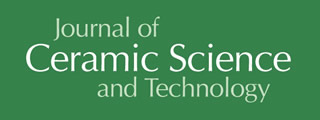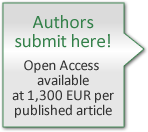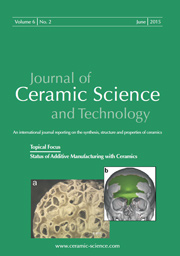Articles
All articles | Recent articles
Effect of Co Co-Doping on the Electrical Conductivity of Ce0.9Sm0.1O2-δ
M.J. Pawar, S.S. Chaure, S.B. Deshmukh
Laboratory of Materials Synthesis, Department of Chemistry, ACS College, Amravati, India, 444602
received March 23, 2010, received in revised form May 26, 2010, accepted May 30, 2010
Vol. 1, No. 1, Pages 27-31 DOI: 10.4416/JCST2010-00006
Abstract
The influence of cobalt doping on the densification and activation energy of Ce0.9Sm0.1O2-δ was studied. Solid solutions of Ce0.9-xCoxSm0.1O2-δ (x = 0, 0.05, 0.1 and 0.15) were prepared by means of a modified EDTA-glycol method. It was found that the degree of densification increases with an increasing concentration of cobalt. Almost full densification could be achieved at a sintering temperature of 1500 °C. The highest density (99.3 %) and minimum activation energy (0.81 eV) were observed for the composition Ce0.8Co0.1Sm0.1O2-δ.
![]() Download Full Article (PDF)
Download Full Article (PDF)
Keywords
SOFC; ceria; EDTA-glycol method; co-dopant; solid electrolytes
References
1 Minh, N.Q., Ceramic Fuel Cells, J.Am.Ceram.Soc., 76, 563-588, (1993).
2 Zha, S., Xia, C., Meng, G., Effect of Gd (Sm) doping on properties of ceria electrolyte for solid oxide fuel cells, J. Power sources 115, 44-48, (2003).
3 Wei, X., Pan, W., Cheng, L., Li, B., Atomistic calculation of association energy in doped ceria, Solid State Ionics, 180, 13-17, (2009).
4 Yahiro, H., Eguchi, Y., Eguchi, K., Arai H., Oxygen ion conductivity of the ceria-samarium oxide system with fluorite structure, J. Appl. Electro-Chem., 18, 527-531, (1988).
5 Kochi, E., Ceramic materials containing rare earth oxides for solid oxide fuel cell, J. Alloys and Compounds, 250, 486-491, (1997).
6 Bryan, G., Glass, R.S., ac impedance studies of rare earth oxide doped ceria, Solid State Ionics, 76, 155-162, (1995).
7 Wang, F.Y., Chen, S., Cheng, S., Gd3+ and Sm3+ co-doped ceria electrolytes for intermediate temperature solid oxide fuel cells, J. Electrochem Commun., 6, 743-746, (2004).
8 Ralph, J.M., Przydatek, J., Kilner, J.A., Seguelong, T., Novel doping system in ceria, Ber. Bunsenges. Phys. Chem., 101, 1403-1407, (1997).
9 Yoshida, H., Deguchi, H., Miura, K., Horiuchi, M., Investigation of the relationship between the ionic conductivity and the local structures of singly and doubly doped ceria compounds using EXAFS measurement, Solid State Ionics, 140, 191-199, (2001).
10 Mori, T., Drennan, J., Lee, J.H., Li, J.G., Ikegami, T., Oxide ionic conductivity and microstructures of Sm- or La-doped CeO2-based systems, Solid State Ionics, 154-155, 461-466, (2002).
11 Yoshida, H., Inagaki, T., Miura, K., Inaba, M., Ogumi, Z., Density functional theory calculation on the effect of local structure of doped ceria on ionic conductivity, Solid State Ionics, 160, 109-116, (2003).
12 Kleinlogel, C., Gauckler, L.J., Sintering of Nanocrystalline CeO2 Ceramics, Adv. Mater., 13 (14), 1081-1085, (2001).
13 Azimova, M.A., McIntosch, S., Transport properties and stability of cobalt doped proton conducting oxides, Solid State Ionics, 180, 160-167, (2009).
14 Pawar, M.J., Gas sensing behavior of LaMnO3 ceramic, J. Opt. Adv. Mate., 9 (12) 3785-3789, (2007).
15 Inaba, H., Tagawa, H., Ceria based solid electrolytes, Solid State Ionics, 83, 1-16, (1996).
Copyright
© 2010 Göller Verlag
Acknowledgments
The author is grateful to the Department of Metallurgy and Material Science Engineering, VNIT Nagpur for permitting the use of the XRD and SEM measurements.


